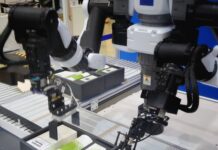Artificial Intelligence has transformed the medical industry to optimize the treatment provided to patients with different medical conditions. There are many types of robots in the medical field. One example of a medical robot is a surgical robot, such as the da Vinci System. The Da Vinci System is a general surgical robot focusing on surgical procedures in urological, bariatric, and gynecological surgical procedures. The da Vinci Xi is versatile and flexible, with setup automation and guidance that promotes operating room efficiency. It provides multi-quadrant access and is used for a variety of complex procedures. Da Vinci Surgical Systems were used in an estimated 200,000 surgeries in 2012, most commonly for hysterectomies and prostate removals. The da Vinci System consists of a surgeon’s console that is typically in the same room as the patient, and a patient-side cart with three to four interactive robotic arms (depending on the model) controlled from the console. The surgeon uses the console’s controls to maneuver the patient-side cart’s three or four robotic arms. The da Vinci System always requires a human operator.
The nature of robotic surgery is less invasive, which means the patient experiences less pain and quicker recovery time. The surgical arms are often pneumatic, powered by compressed air and electricity to control the operation. The hands of each arm, which hold the necessary surgical tools, are also smaller than human hands, which eliminates the need for large incisions. Some surgeries, from orthopedic operations to neurological procedures, require a high degree of accuracy. One slip of the scalpel or a misplaced set of forceps can cause damage or even result in the death of the patient. Robotic surgery robots aren’t susceptible to the shaking or other strain-related movements a human surgeon might experience. If the controller’s hands are shaking, the machine’s software compensates for that movement, so it doesn’t affect the surgery.
However, Surgery can be an expensive proposition to sustain. The high cost of installing a robotic surgery system can increase the cost of a surgical procedure. Surgical robots are costly to maintain, and their operation requires additional training, which is also expensive. One of the most significant problems with robotic surgery is the issue of latency, which is the time it takes for the robot to carry out the surgeon’s commands. It takes a few moments for the computer to communicate with the robotic arms. While this isn’t an issue for routine surgeries, it makes it difficult for surgeons to respond quickly to problems that occur during the operation.
Another example is care robots that are used to provide care and support to elderly and disabled patients. Care robots can assist nurses with the multitude of tasks that they perform on an hourly basis. Many of these tasks are simple but vital, such as taking blood, recording temperature, or improving patient hygiene. If robots were able to help with these simple repetitive tasks, it would give nurses more time to focus on individualised patient care and devising treatment plans. An example of a care robot is Mabu. Mabu, the personal healthcare companion, is an intelligent, socially interactive robot whose conversations are tailored to each patient that she works with. Mabu is the face of Catalia Health’s platform for patient engagement. She’s designed to help patients with challenges of chronic disease management and was first rolled out this year to help a particular group of patients manage the medication portion of their treatment. Treatment plans for chronic diseases can be challenging for patients to manage consistently, and many people don’t follow them as prescribed. Kidd says Mabu’s daily conversations help not only patients but also human caregivers as they make treatment decisions using data collected by their robot counterpart.
Mabu, with its small yellow body and friendly expression, serves as the face of care management. It has an engaging interface that blinks, makes eye contact, and uses AI to have intelligent, tailored conversations and improve patient care via daily check-ins. The robot is the key to long-term patient engagement that evolves, using principles of behavioural psychology to tailor daily patient conversations to obtain hard-to-get data about treatment challenges.
The nursing robot system is designed in such a way to assist bedridden patients with simple services, and such a robot is typically confined to the patient’s room in the hospital or at home. Nursing-care robots can also carry out laundry services as well as other household chores, and with a human-like voice for greeting patients awakening from sleep. It has to be pointed out that, although at the moment robots are supposed to administer any medical treatment to a patient, they could be programmed to do so.
Care staff are often on their feet for hours at a time, which can cause exhaustion and stress. Care robots allow the surgeon to sit comfortably while tending to multiple patients. Nursing-care robots can be easily provided with surveillance equipment that can give them the capability of monitoring their patients, recording the related data, and communicate information wirelessly. Although such a feature can prove to be useful to safeguard aged patients by establishing virtual proximity with their relatives or healthcare providers, it could also lead to a violation of patients’ privacy.



















